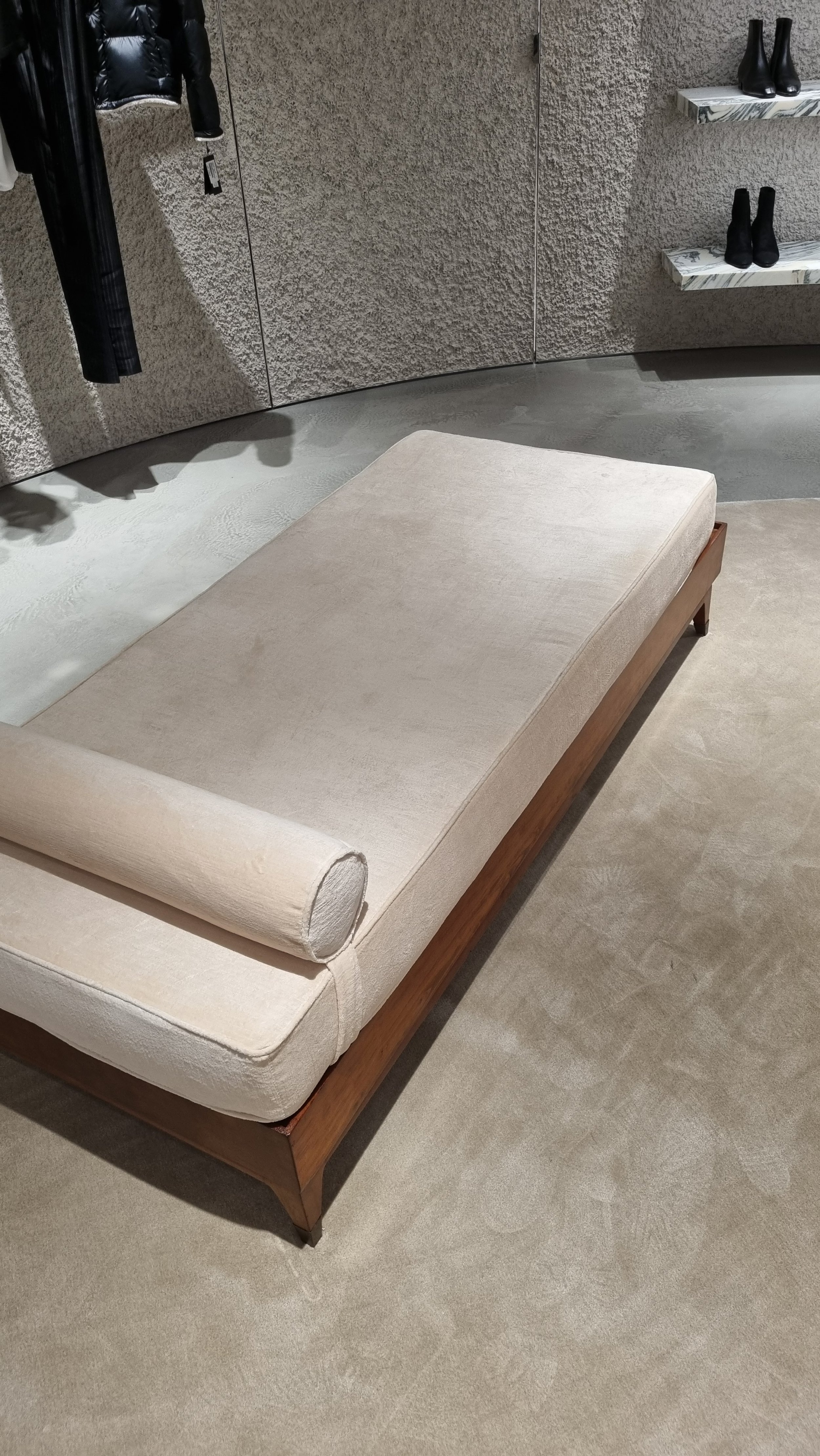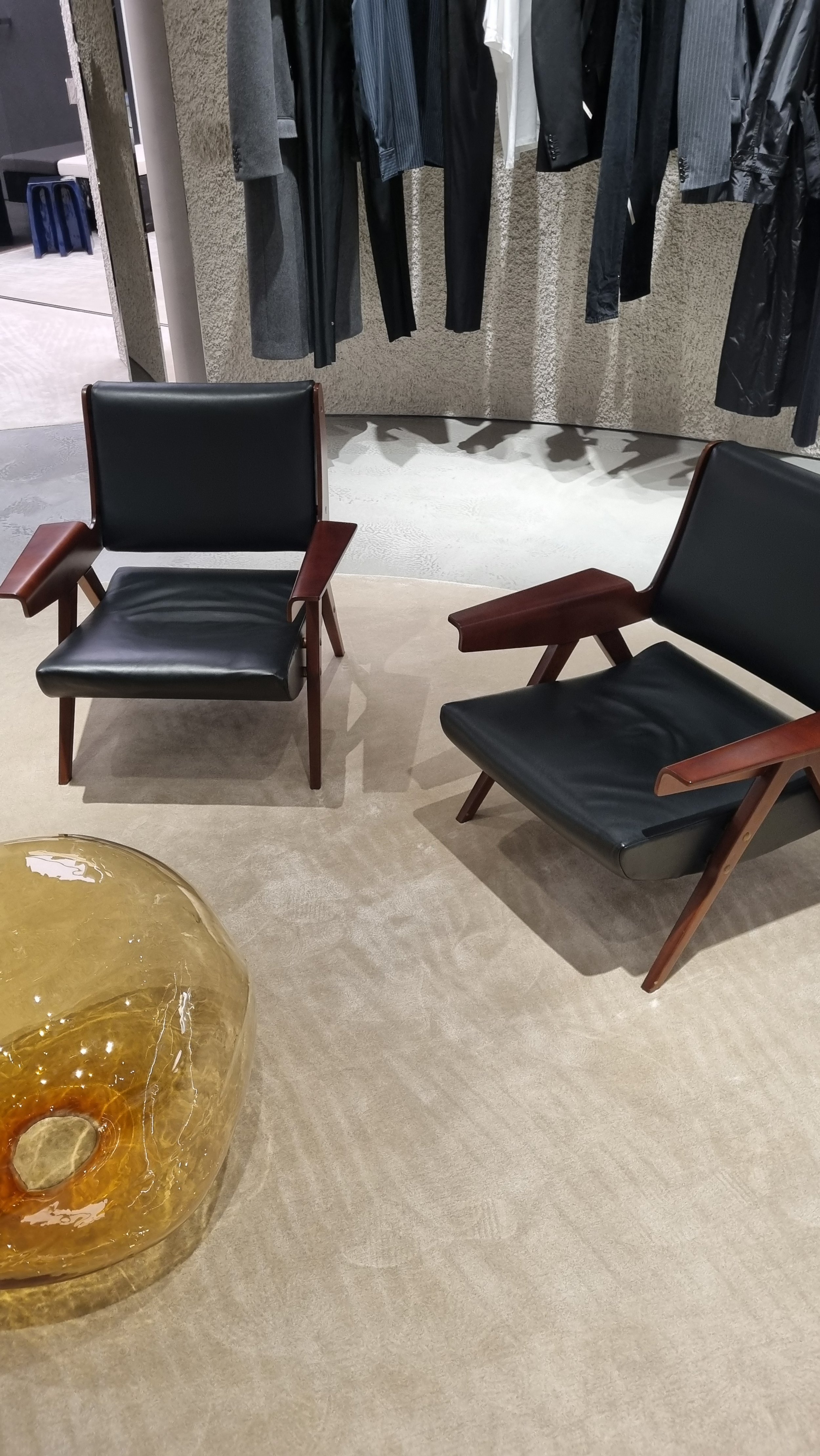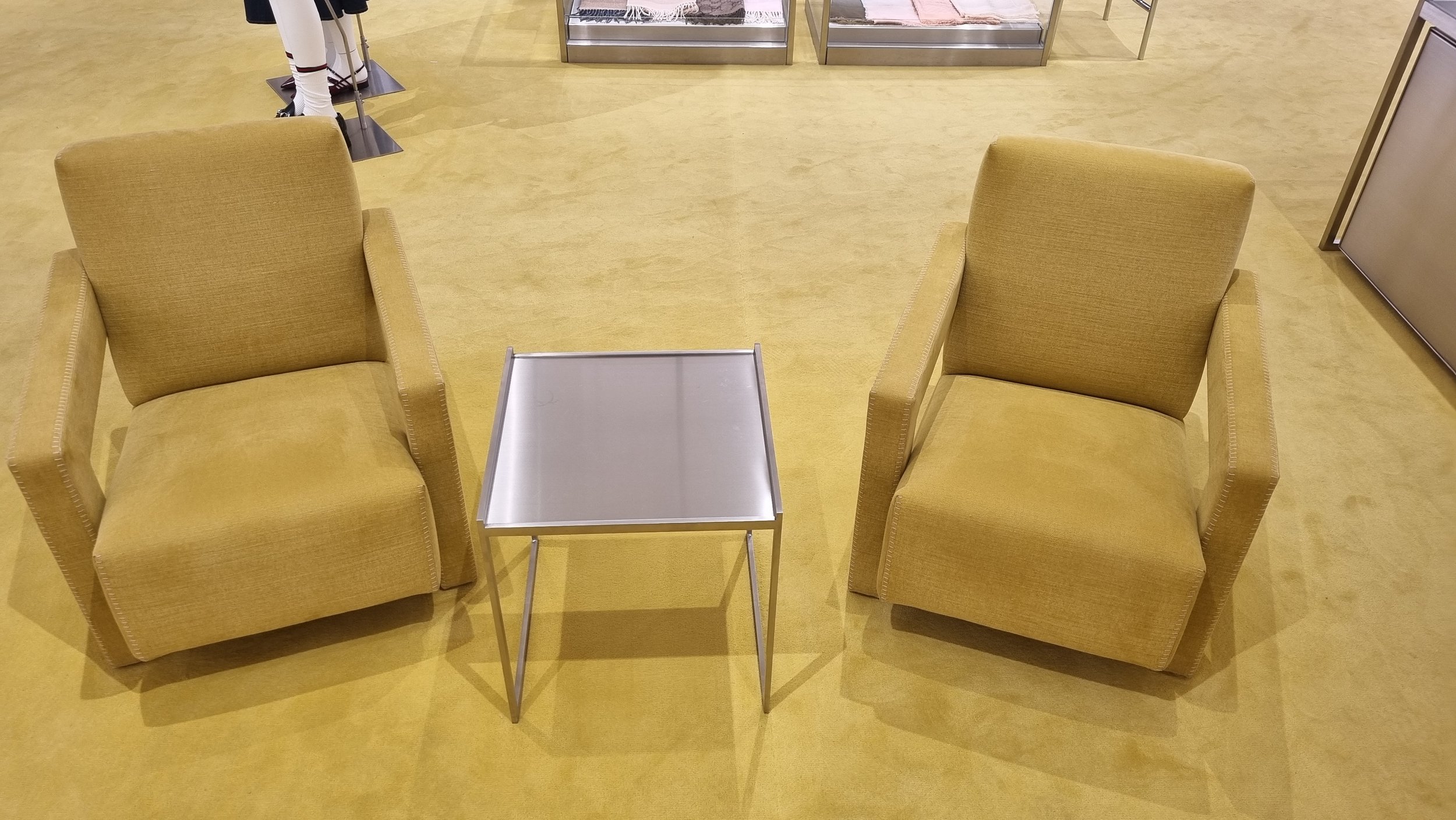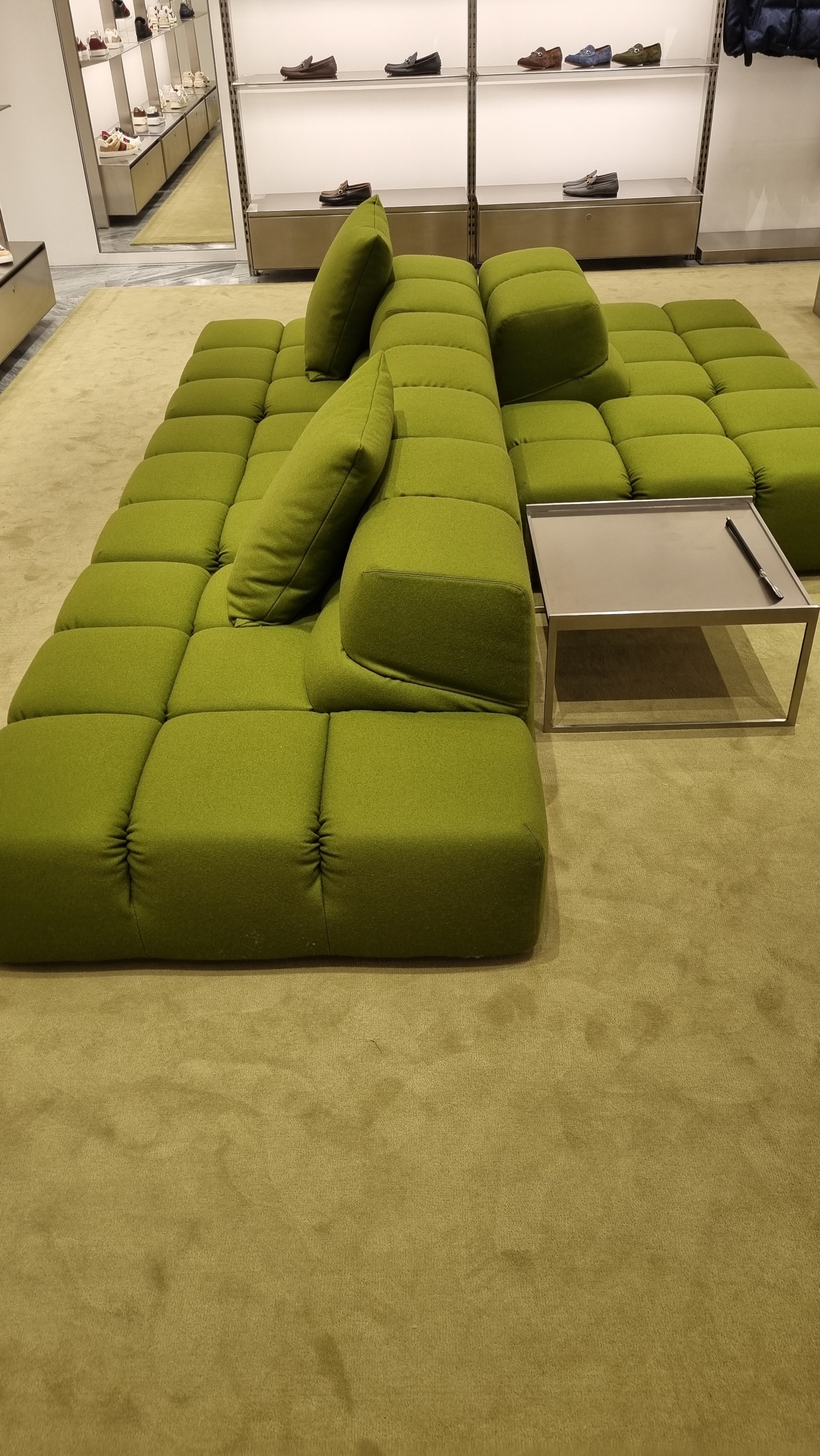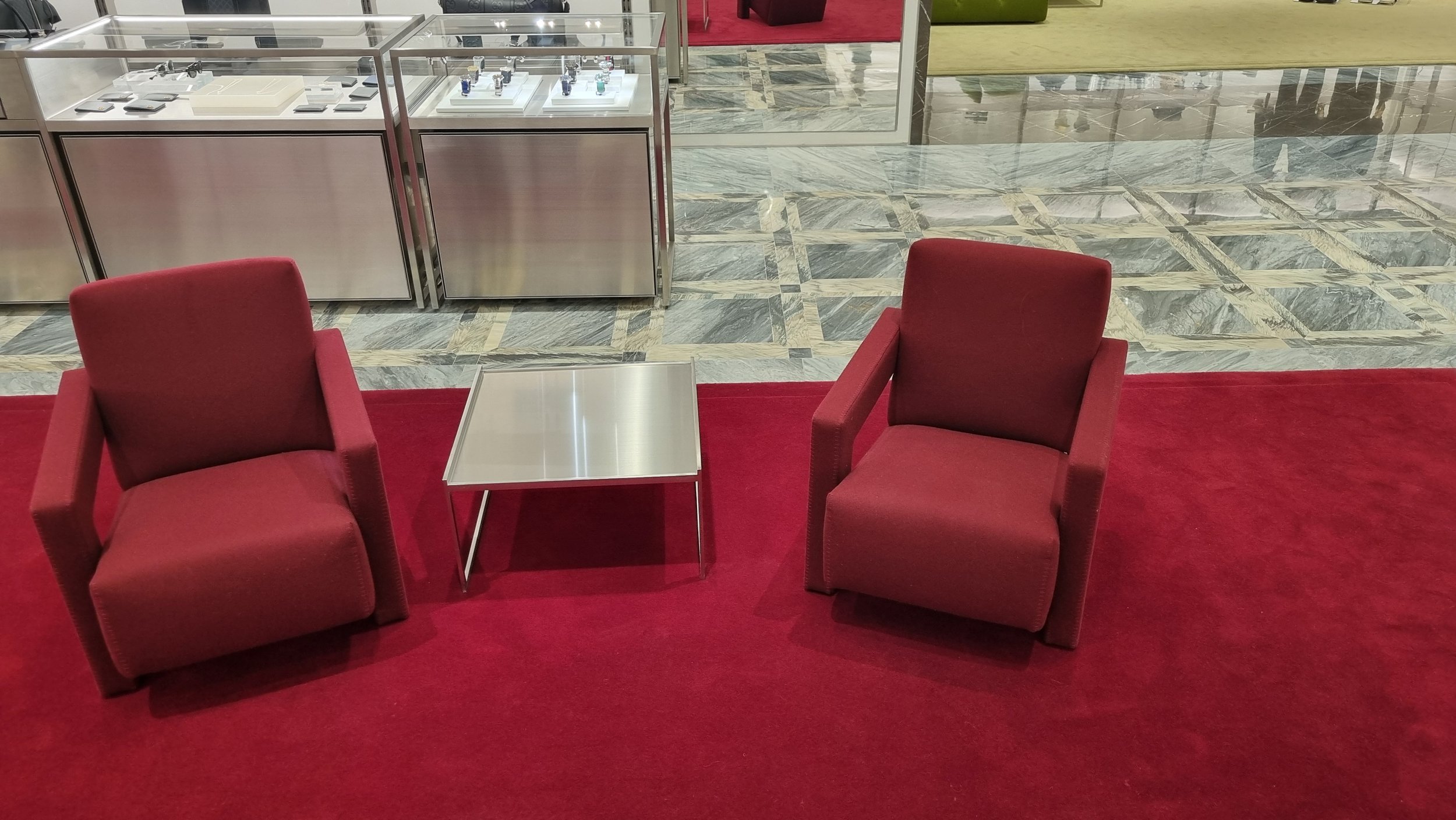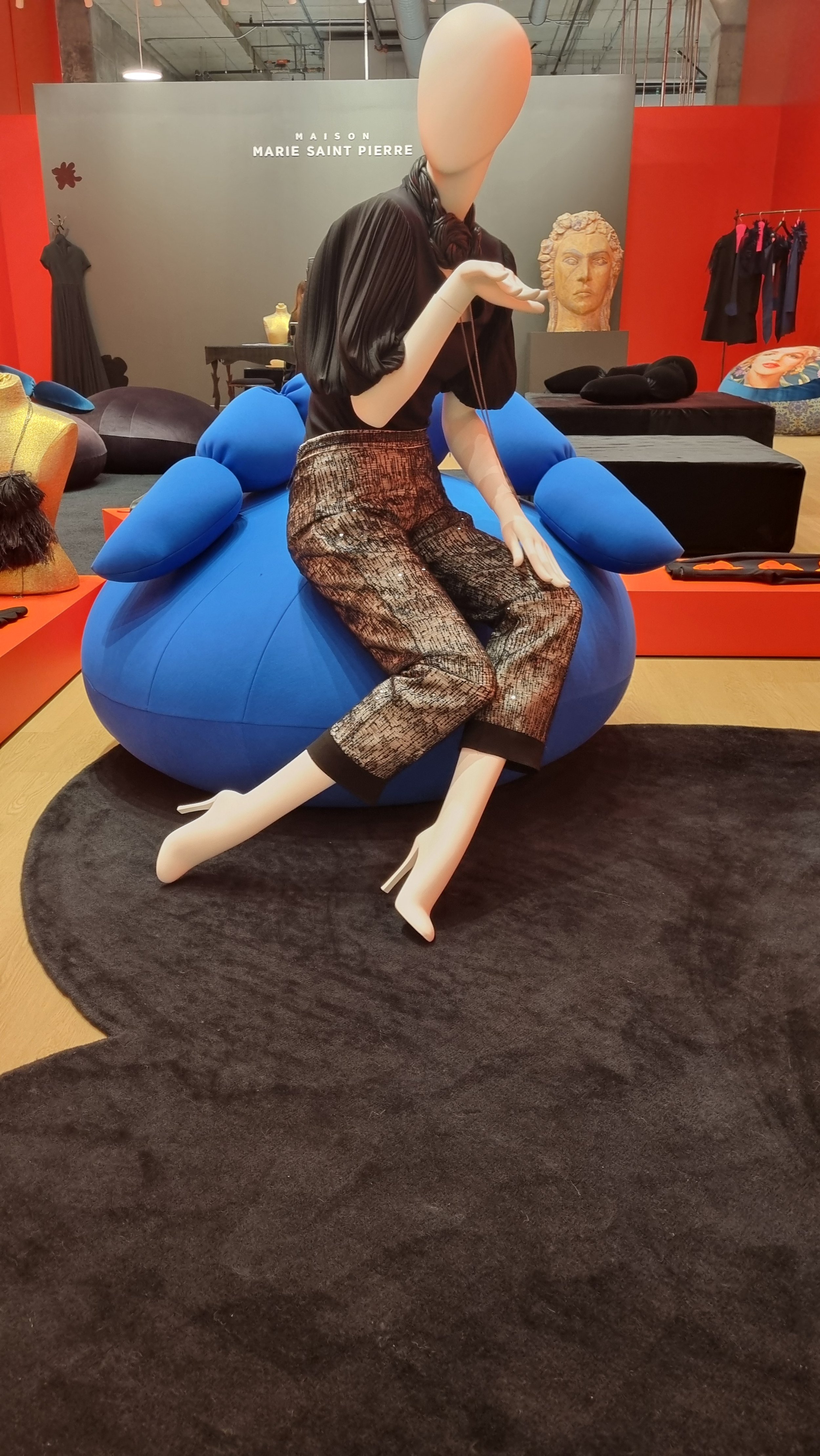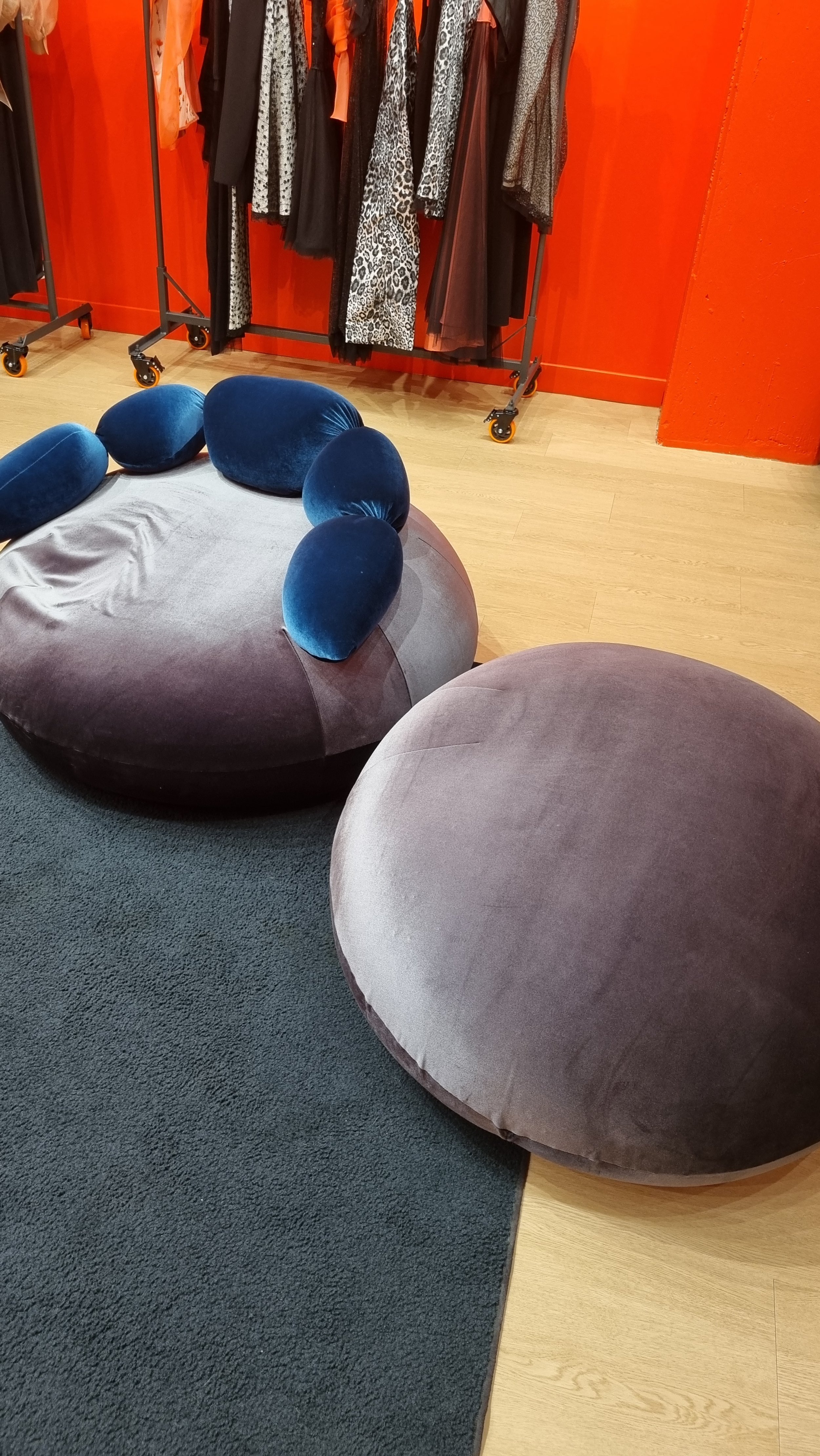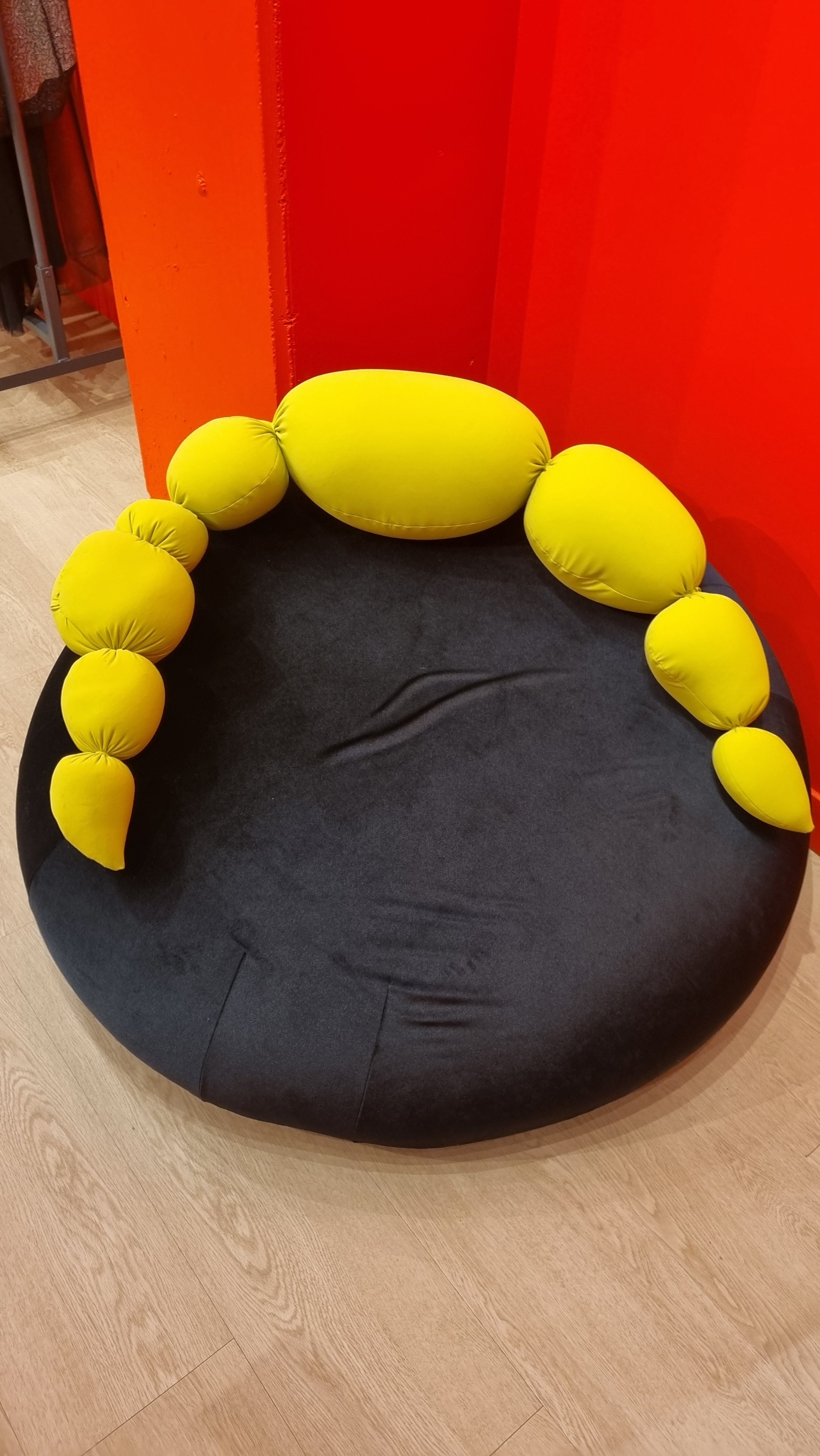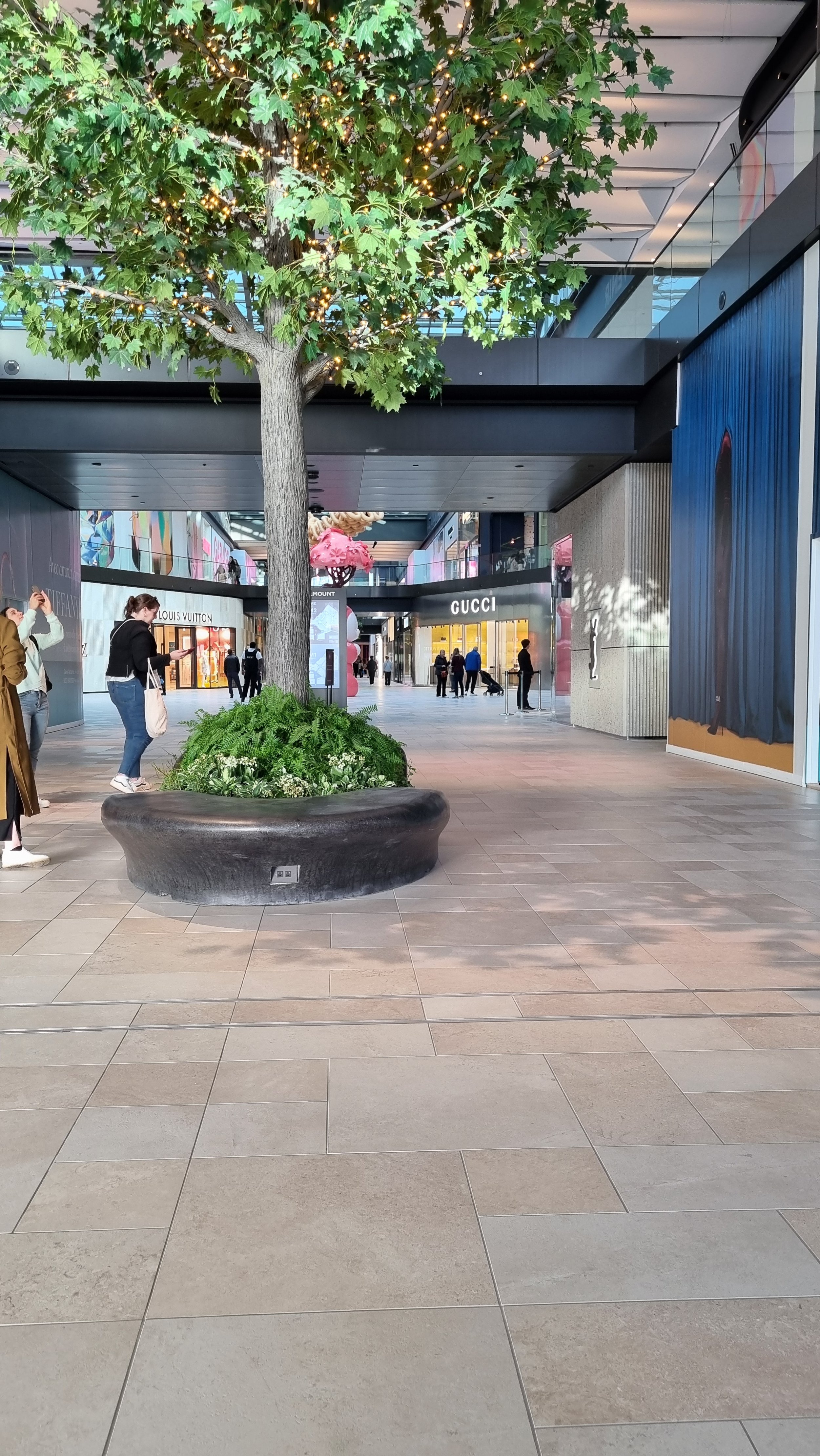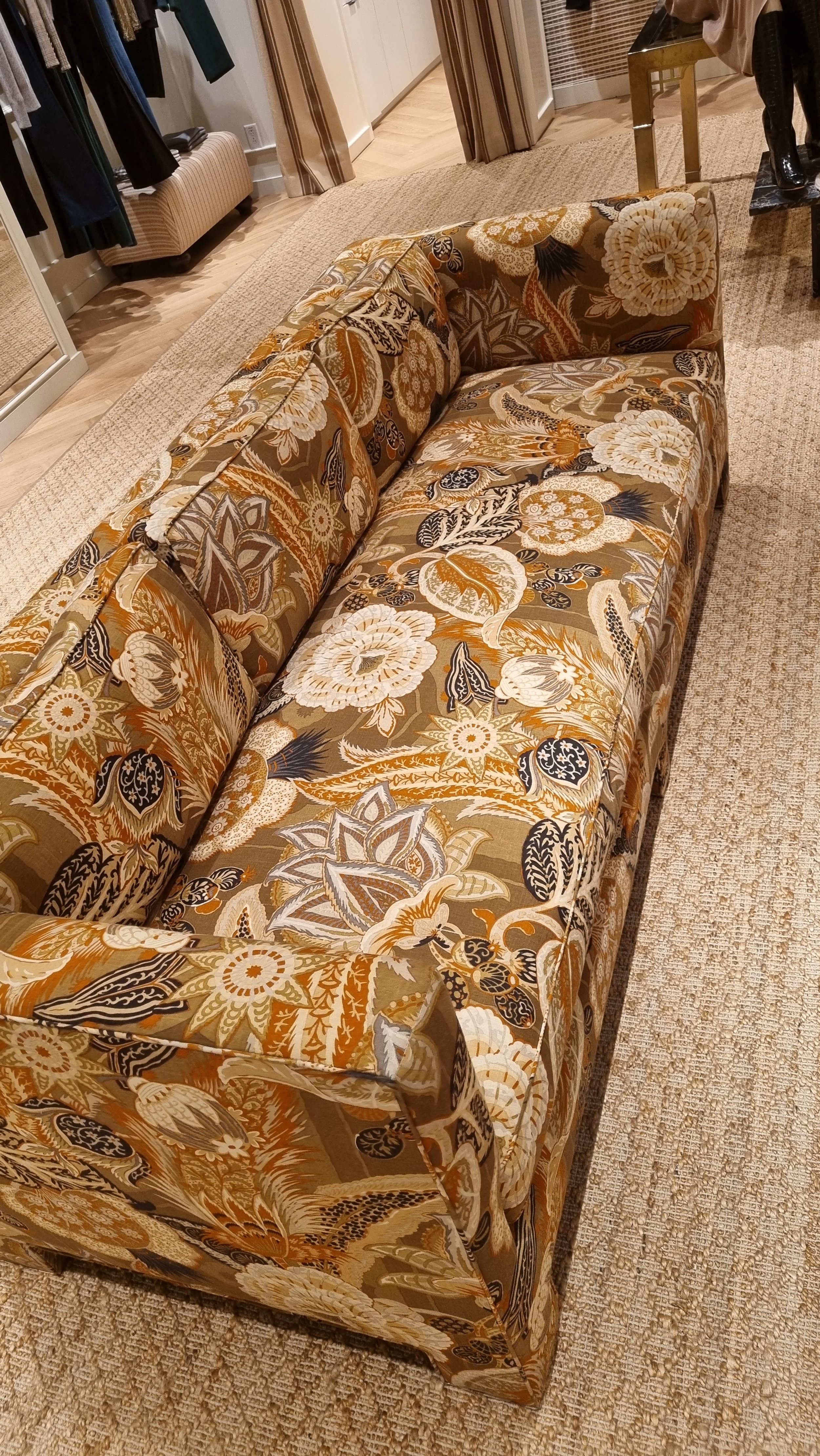Upscaling Democracy – Sensing the democratization of luxury
by Jayanthan Sriram
“Luxury is intrigue and deceit, domination and abstraction.” (Calefato 2014, 1)
Traveling via the Metro to the De La Savane stop and exiting towards the surface, the complex of the Royalmount Mall appears in the distance. The division created by the sunken Decarie expressway which instersects with Transcanada highway at this juncture is spanned by a futuristic tube of light/pedestrian overpass hovering above. Entering the bridge of light after a sign on the opposite side tells you of the Church of God of Prophecy fulfills a promise of secularity only a mall can make. (Later, when returning through the bridge after nightfall, the traffic underneath provides a lightshow itself, blending the transition and liminal experience of spaciousness into a slow descent back to the reality of Montreal’s old and bleak underground system).
The promise of luxury is what drives me to seek out malls on a regular basis, especially on account of my love for perfume. The latter disposition grew out of an early obsession with the eternally unaffordable – designer clothes, cool sneakers and electronic gadgets. Years later, Patrizia Calefato’s words would echo this sentiment, when she speaks of “modes of production in which commodities and signs, primary goods and passions intersect” (Calefato 2014, 79). Luxury is more than mere wealth. The passage towards the Royalmount appears to speak of the intersection of extreme baseness and the extreme limit, the extreme democracy of reaching this mall by public transport and the extreme elevation of the shopping experience through high end fashion brands and walking over traffic to do so.
Yet approaching the entry foyer after the walkway, with its clean, white and largely deodorized open space lets me immediately think about the purpose of this temple of and to consumption in the middle of what seems to be an industrial park and a working-class sector of the city. As large LED screens repeating a Porsche ad collide with the mall’s advertised project of highlighting a variety of visual artists by letting them showcase their art on the walls, the mall appears to drive home the fact that the atmosphere of luxury, of a ‘free’ and expansive shopping experience speaks to a higher purpose of existence. The ontological drive of seeking out malls exceeds the drive to be enticed and spend money, even if this remains its ultimate purpose from a ‘classic’ capitalist standpoint. The huge walls of art, screens and calming mix of white light and skylights speak to the affective need of humans (Boehme 2001, 20), expanding luxury from “waste” to enticement as the “very nature of humankind” (Calefato 2014, 8).
In contrast to my usual Montreal mall experience of the Eaton Centre or even Holt Renfrew, the scale of Royalmount is impressive. While the hallways and open spaces of other malls sometimes feel claustrophobic and like walking in line shoulder-to-shoulder with other visitors, at Royalmount, even on a Friday afternoon and multiple Friday afternoons at that, one can encounter completely empty parts and almost walk through some corridors alone. The spaciousness might evoke a void, were it not for the screens and art on the wall. Dua Lipa pushing me to buy a Porsche Macan feels strange and out of place for a mall that does not sell cars (there are car dealerships dotted all around the junction of the Decarie expressway and Transcanada highway, as I found out later), yet it adds to the spectacle of things I cannot fathom possessing. So yeah, I’m certainly in the market for a car, basing myself in the dialectic of “need and desire” (Calefato 2014, 27) as luxury simply exceeds necessity and becomes a sensory experience to dwell within. Calefato goes as far as to understand culture and thought a luxury beyond the need for human existence, doubling down on the paradoxical nature of what we need to survive and what we want to thrive and be human – so I find that the car ads and large-scale art doubling as advertisement and social media backdrops marks atmospheres of luxury as teaching us that “there is always something more” (Calefato 2014, 27).
Before entering the mall and its stores, the garden/park that can be reached from either the parking lot outside or via various entrances from within the mall, externalizes the vastness even more. Framed by huge screens on the outer walls of the mall, the major stairway to the main entrance and foyer of the mall open towards a garden space that embellishes greenery with functional seating arrangements and water features. Most seating spaces allow for phones to be charged via USB ports even. When not gazing beyond the framing of the walls and construction still underway, the park feels like a transplanted public space. In the middle of this industrial park however, the widening scope still offers shiny brutalist architecture and a proximity to highways before allowing for a vision of nature. A metal slide offset by its own bridge and stairs serves as the immediate selling point of bringing my son to this place in the summer. While malls themselves are rarely family friendly, this form of physical entertainment – just something to do while the parents waste their time – may not qualify as a full playground but suffices to provide some kind of activity that doesn’t bar children’s hands from touching anything or seems dysfunctional for their understanding of fun (i.e just looking at things).
The park area combines with the artwork gracing various walls and even some sculptures as part of the experience of space and a polished shopping experience. While the artwork-covered walls always reference the artists like in a gallery, the visuals themselves are simply nice and draw you in, without seeming too heavily thematic or political. The ability to fill the void and provide an altered sense of space and time appears as a branded approach, nothing is there by chance – it all serves the marketing of the place. This is Boehme’s aesthetic labor at its most potent: the fashioning of bodily and sensory experiences with the affective need of humans in mind, not simply breaching functionality, craft and the arts, but utilizing aesthetization to create atmospherics that serve a purpose without opting for any transcendental notion of free-play in the encounter of ‘the artwork’.
This becomes striking when realizing that the aural experience has been seamless from the inside to the outside. The garden section of Royalmount - similar to every interior hallway and corner - booms an incessant blend of ambient music leaning towards deep house. Outside this is done through Bose Freespace 360p speakers, green, almost pot-like devices submerged half into the ground.[1] One could mistake the speakers as part of the greenery itself, were it not for the spatiality of the sound when approaching one of them.
In contrast to most mall settings, the music here appears instrumental only and not interested in playing the most recent pop tunes. As a fan of visceral techno experience by the elusive Shinichi Atobe or the work of the late Susumu Yokota, the combination of landscape, mall interiors and lounge vibes that still have driving melodies and low-end to them, this playlist-guided aurality takes the artistic craft of environmental music to its functional conclusion.[2] This 360-degree envelop of muzak made to resonate throughout, merging with nature, a drink at the food court and the shopping experience overwrites the serial feeling of malls and their products for the luxury of not relying on the world or the speed of pop-music that seems to dictate the everyday – upscaling by spatializing our aural understanding of self.
Regardless, when entering the mall again from the ground floor, one comes to realize a striking inversion of upper and lower floor in the boutiques present and the perceived wealth needed to shop at certain spots. As the public would usually enter the mall via the pedestrian overpass from the metro station,, the upper floors house the rather middle-class stores of brands such as H&M, Zara and Uniqlo, while the lower floors are almost exclusively occupied by high-fashion boutiques and their complementary boutiques in cosmetics and accessories. Understanding luxury as a deeply human component of existence, one that anthropologically materializes “expenditure, futile excess and the realm of the nonfunctional” and is not simply rooted in a capitalistic understanding of wealth (Calefato 2014, 9), the inevitable – even if accidental – division of space and spaciousness serves as a necropolitical reminder of variant degrees of “haves” and “have-nots”. I am reminded of a Google review professing the downfall of Royalmount in approximately three years time due to the financial inaccessibility of luxury brands occupying the space, adding the snide remark that after this period, Dollarama will move in and equalize the opportunities to spend!
The spatial center of the lower floor appears cruciform and holds a 3D printed Teddy Bear as a waypoint framed by the boutiques of Gucci, Louis Vuitton and Yves Saint Laurent. These boutiques embody the very ideal of flagship stores in their large scale and uniquely designed wall textures, designs and flooring – from shiny marble and tiles to brutalist concrete and the ever-present ad featuring models and products. Markedly individualized from the experience of the same brands in Holt Renfrew, the liminality of entering the boutiques is maintained with artificial lines and security guards / ushers safeguarding the entrances. While I’ve transgressed many times into the boutiques as someone who likes to look but would and could never spend any amount required to purchase a pair of shoes, suit or bag, trying to cross into the designer basilicas is a Kafkaesque hesitation before birth that makes you poorer the longer you service the gate. Still, the ability and even invitation to just stroll into these boutiques (even if the security guard gives you an ‘I know you won’t buy anything’ look) is a visceral play of the “democratization of luxury”. This democratization does not stand for the access, but the excess of luxury that needs to exceed itself in its display and indulgence to “disrupt democracy” and create division (Calefato 2014, 35-36). I cannot forget that apart from my rare and occasional indulance to fulfill a dream of quotidian excess, for instance in buying something that costs too much and cutting down on something else like better food or functional clothing, the availability, display and actual acquisition of these goods differs in meaning and phenomenological comfort for those that have left the scale of purchasing power and simply do not need to weigh their options and comforts in life anymore.
Stepping into the boutiques of Gucci and Yves Saint Laurent, the high fashion shopping experience renders luxury as the opposite of narrow corridors with piles of clothes. The objects here -the select shoes, clothes, bags and accessories on display - are allowed to breathe and appear almost singular,as if a craftsman just finished adjusting the suit and every pair of shoes exists just in the one size on display. Touching the materials, feeling and smelling the leather of some loafers for instance, I still, for the life of me, cannot distinguish the craftsmanship of the products from other, more strikingly serialized wares. The courage I muster to touch what is known to cost upwards of $1,000 CAD lets me ponder how nice it is to find the right clothes in the right size on a sales rack – and find happiness in spite of paying less for something I deem almost worthless in material and durability. During my hunt for textures and resonances of quality and material prowess beyond what I think cotton and leather feel like, the salesclerk approaches me and gives some details about the collection and design of the pieces at hand. This pitch alone helps “avoid the flat uniformity of serial production” (Calefato 2014, 37), constructing this intricacy of thought and skill needed to become a YSL loafer. The brand’s name alone, the symbolism edged into the initials lets my understanding of clothing waver from the functional to the desirable that weaves into my identity. In my youth, the thought of possessing a Dior fragrance made me believe in the potential of buying into a special group of people, a membership into the finer things. Today, I wear 20 Dollar band shirts to become part of a secret sect and show my taste to those that know to reads these symbols, and now I consider the same meaning in the sect of Saint Laurent or newer iterations of ‘quiet luxury’ for those that are ‘in the know’. I know that this here is part of a branding structure and “controlled consumption” for the masses, letting everyone partake in the luxury of the elite (Calefato 2014, 11) – touch it, smell it, hear it, but buying it? This rationalization alone does not, however, guard me from being entrenched in the atmospherics for a while, thinking that it might still be something for a later, better life.
Reassessing towards the task at hand, I am drawn to have a seat on one of the many sofas in the boutique. Most boutiques on the lower floors have some kind of seating and furnishing that seems to reflect higher quality, but also acts as an invitation to sit down and take in the space. Or even experience respite from shopping for something within the place made to accomplish this. Strangely enough, the ability to sit down and recalibrate speaks to the notion of luxury that goes “beyond utilitarianism and beyond any price”, “speaking to us precisely of the senses” (Calefato 2014, 15). I often find myself in need of a seating opportunity in regular clothing establishments, especially when being dragged to shop as a witness and in the illusion of collective decision-making, and standing still at an H&M or taking in the room of a Uniqlo may reveal problems of the space – unkempt arrangements, trash on the floors or the clutter of it all. The clerk at Gucci, suited up and dressed to a tee, assures me that everything I see is made in Italy, even the heavy marble displays. My question if the store itself is designed by a specific person or even head designer of the brand is left unanswered.
At YSL, what I can only define as ‘the liaison’ of the boutique is nice and inviting after I’ve completed my musings and short sampling of a seat. The conversation ranges from the availability of the private fragrance line in the boutique itself (the line can only be found at the general perfumery / cosmetics section Rennai) to our favorite fragrances from YSL and beyond, discontinuations and the overall meaning and value of opening a flagship at Royalmount. Reflected by a few other conversations of the afternoon, the imminent (but seemingly not promised) arrival of Dior and Chanel will seal the deal of Royalmount as the location for luxury shopping in Montreal. It appears as if the brands have no choice but to expand their business here, for presence before prestige. I think about parent company LVMH’s widely publicized ‘slump’ in sales, with projections falling 1% short of 2023 and the company itself hitting record highs after CoVID lockdowns ended and international travel normalized. In this hope of becoming a staple for luxury shopping in Montreal, not in separate stores, but pretty much in the neighborhood of A&W upstairs and middle-class clothing brands, I think the proprietors, clerks and people working the floor believe in the project of malls “turn[ing] territories of luxury into everyday places” (Calefato 2014, 39).
Considering the meaning of this for the neighborhoods close to the mall and beyond the industrial park – or the people choosing the Church of God of Prophecy to worship – I cannot help to jump from Gucci to Gentrification and its many forms and approaches. It may not be the act of shopping or the prospect of ownership of these goods, but the transformation through presence, inhabiting a space to claim its significance and future relevance (Calefato 2014, 21). Feeling upset at this prospect of uprooting others and actively participating in this in one form or another, I walk through the mall at a higher pace and with a focus to look at the seating arrangement of various boutiques. From cheeky bean bags to intricate sofas, the seating feels like an invitation to break the rush of shopping or at least more consciously spend your money. Outside, in the hallways, the curving stone seating is, paradoxically, the most prestigious iteration of hostile architecture yet (Lynch 2021) [3]. (Seating Gallery below)
I consider this taking of time to rest in the context of shopping for electronic gear: having the ability to spend a good hour on a device, trying it out, testing it with effects or your own gear you bring from home. Or closer yet, the invitation of good perfumery to not make a hasty decision, leave the boutique and let the perfume sit and develop before purchase. Yet, none of these seating arrangements allow shoppers to meditate on a shoe or piece of clothing and unwind with the material in mind. While sinking into a bean bag at the request of the clerk to try them out, as they are also for sale, I revel in the intricacies of each painted wall and lighting rig and dummy model dressed – the “calm and sensual delight” that seems connected to the “durability of things” (Calefato 2014, 34) to purchase but projecting their ecstasies into the timespace for everyone to experience.
This leads me to think that the biggest achievement of the mall lies in its sense of scale that offset my usual understanding of space. From the fuzzy pillars and selfie stations erected to please the passerby, the mall brims with empty space. It breathes spaciousness. Other than my usual commute with the metro and public transport, or the experience of inner city malls, space and, by extension, the time to dwell in space appear removed from the purpose of the actual place, an “ultimate” and “new” luxury (Calefato 2014, 46) that speaks to our contemporary condition as city-dwellers and the push and pull of everyday life and its drive to be productive. I certainly cannot afford much in the lower floors of the mall, but I can afford partaking in the excess from a bodily standpoint, it might only cost me some ounces of sanity to dwell in the spectacle of it all.
This is best reflected in my favorite place to visit, the perfumery. The most exclusive brands at Royalmount appear to be Diptyque and Le Labo, as they hold their own enclosed space and boutique-like structure away from the open space counters inside Rennai. Le Labo, a still recent purchase of Estée Lauder and formerly an indie darling founded in New York and talked about in regal praise by most fragrance forums online, becomes the place I dwell in the longest. The setup of the boutique plays with the barebones and opacity of the madeness of perfume. As in the scents that only bare their main ingredients with a numeric signaling the number of ingredients in the fragrance, the boutique evokes a high-end but medieval apothecary and workshop that holds all the ingredients and knowledge of the craft in its walls. The walls especially, as the clerk is quick to point out, follow the model of wabi-sabi and non-fini aesthetic, they are textured, open and reveal their surface as their underside. As we strike up a conversation about the fragrance Rose 31, a scent I’ve been meaning to try for a long time, the clerk is whisked away by a rude customer interrupting our exchange and demanding to smell Baccarat Rouge, a fragrance by Maison Francis Kurkdijan (MFK), another LVMH purchase. The rude customer needing to get his hands on a hyped fragrance from five years ago seems to disregard the textured wall and setup of the boutique as much as the clerk’s position within the space. When found in the open-door cosmetics section, the experience of both Le Labo and MFK fragrances is equalized and somehow disconnected from the individualized notion of their humbler origins of crafted experience (Calefato 2014, 91). I still believe in a strong connection of fragrance and wearer, a transformation and transfigurement of identity and projected self in the shared atmosphere of wearing a fragrance, yet the overarching “christening” by a brand (Calefato 2014, 16) and their appearance under the helm of holding companies disperses the resonance and makes me question the splendor of aesthetic labor in its full realization.
I return to Royalmount with my family on a Friday afternoon a week later, mostly to give our son the opportunity to play with the fuzzy pillar and indulge in his own spatial delight of riding the elevators and escalators. In this leisure of not trying to sense keenly and think about the composition of the atmospheres to hard, and in defending my Jugo Juice smoothy from small hands that indulge too fast while running the risk of brain freeze, I phase back into the idea of luxury before consumption in the goods on display. The mall as a cosmos and the lower floor boutiques as small, intricate galaxies of their own truly embody a “world theater where time exists only as a pause” (Calefato 2014, 54) wherein the promise of materiality – of looking upon the ingredients or hearing about the designers and their intent fulfill a desire to contrast mindless consumption with even steeper prices as dreams you cannot afford.
In conversations about the splendors of the mall and the shared experience of spacious indulgence, my partner and I turn to the recurring comparison of luxury and war, their similar “exorbitant expenditure of energy, knowledge and means of production” (Calefato 2014, 31) either for the enticement of our sense of self or the destruction of others. Critical of our cultural climate and embedded in our histories of migration, we view our own indulgence and partaking in the splendor as a paradoxical reality of existing under the safety of floating installations suspended from the ceiling while others are bereft of returning home in facing the forces of kilotons of bombs dropped from the sky. At least for us, the ability to sit down amidst the instrumental litany of house music accentuating the timespace of ‘live a little’ creates a phenomenological propinquity to the “dark machinery” underlying the financial weight needed to create these megastructures. The atmosphere of “economies that devour politics” (Calefato 2014, 95) bandage to the inherent human need to be enveloped by the non-functional and enticing. Nevertheless, when breathing this timespace, we cannot help but listen to cost and purpose, the laws of luxury that root themselves in the dissipation of needs, disposing others and challenging the bodily integrity of our everydayness (Calefato 2014, 95).
Bibliography
Calefato, Patrizia (2014), Luxury – Fashion, Lifestyle and Excess. London: Bloomsbury.
Böhme, Gernot (2001), Aisthetik – Vorlesungen über Ästhetik als allgemeine Wahrnehmungslehre. München: Fink.
Lynch, Erin E. 2021. “Laws of Perpetual Motion: The Sensory Regulation of Mobility in Public Space.” The Senses and Society 16 (1): 102–9. doi:10.1080/17458927.2020.1763037.
[1] https://www.boseprofessional.com/products/loudspeakers/landscape/fs-360p-series-ii/freespace-360p-series-ii)
[2] for reference, a Shinichi Atobe track, which may never resound through the halls of Royalmount for its obscurity, but feels reflective of the larger ‘vibe’: https://www.youtube.com/watch?v=F9QM3WC0TKA).
[3} https://www.tandfonline.com/doi/full/10.1080/17458927.2020.1763037).
